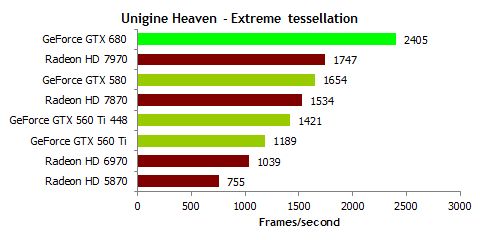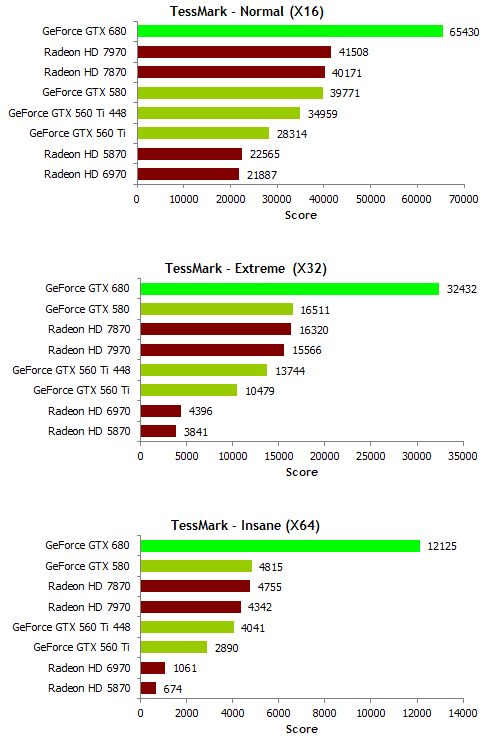
The guys at techreport.com have benchmarked the freshly new released GeForce GTX 680 with TessMark, the OpenGL 4 tessellation benchmark, and the results are pretty impressive, especially with the insane tessellation factor of X64:
Same thing in Unigine Heaven, the GTX 680 is far ahead of other cards:


On compute tasks it’s viceversa )), it’s definetly a gaming card ))
still don’t believe that 7xxx cards are faster than 560Ti with only two tesselators
@Corwin
But you can believe that 8 PolyMorph engine Kepler is much faster than 16 polymorph engine Fermi?
Promilus
AMD is AMD, NVidia is NVidia. NVidia can.
still cannot believe nobody is using this:
http://www.youtube.com/watch?v=QDxdAWH__Ps&feature=youtu.be
http://www.youtube.com/watch?gl=US&v=SjhM_xc6Yes
A new Dawn is Approaching. . .
@Corwin – bullshit. Tesselator isn’t unit with fixed performance (i.e. 16 additional triangles / cycle or so). Unlike ROP (1pixel/cycle) or TMU (1 texel/cycle) it’s throughput can vary depending on situation (that’s why AMD could get some perf. boost with just improved buffering for tess unit in Barts and later again boost by combining new buffering * 2 tess). Now again in Tahiti we see improvements in single tess so 1 tesselator performance might look like that:
7970>6970>5870>680>580
2u > 2u > 1u 16u
@up – sh*t 😉 last line was corrupted, however I think you know what I meant.
@JeGx new intel HD drivers are out and now it exposes 129 OpenGL extension previously it was 116.. check it out … Sorry for posting here
With new Intel HD drivers all the openGL demos are working fine … including HW Geometry instancing .. previously it does not even start because of missing extension…
sweet thanks NEO
These are the links … 32 bit and 64 bit
http://downloadcenter.intel.com/Detail_Desc.aspx?agr=Y&DwnldID=21030&ProdId=3319&lang=eng&OSVersion=&DownloadType=Drivers
http://downloadcenter.intel.com/Detail_Desc.aspx?agr=Y&ProdId=3319&DwnldID=21033&ProductFamily=Graphics&ProductLine=Processor+graphics&ProductProduct=2nd+Generation+Intel%C2%AE+Core%E2%84%A2+Processors+with+Intel%C2%AE+HD+Graphics+3000%2f2000&DownloadType=Drivers&lang=eng
The compute software is not optimised to take advantage of 680 yet.
@feathers
No. It is fault of that design. For compute (not simple math but heavy data) new SMX are only better from VLIW4/5 SIMD Cores but are worse than older Fermi SMs and new GCN SIMDs (that’s why Kepler loses even in Civ V ComputeShaders test). That architecture resembles some of previous AMD designs. VLIW was quite effective in games (pixel shader mostly) and had some fine uses in Collatz Conjecture @ Home (thanks to great throughput of simple math and fine integer + bitwise performance), bitcoin mining (same as before) or MilkyWay@Home (FP64 performance not artificially limited). GK104 is also game oriented architecture and not heavy compute. It can do all those complicated tasks but is not as efficient as Fermi so it takes twice the Fermi peak performance to get about the same real life performance.
AMD is for loser!
One thing that should be noted is that the Radeon 7k[7970 – 7870] have only 2 Tesselators, whereas the Kepler 680 has 8. One AMD Tesselator seems to have 1.5-2X performance over one Nvidia Tesselator.
Now my problem is: AMD wy y no fit more Tesselators into GPU Design?